Antibody data
- Antibody Data
- Antigen structure
- References [0]
- Comments [0]
- Validations
- Western blot [1]
- Immunocytochemistry [1]
- Immunohistochemistry [3]
- Flow cytometry [1]
- Protein array [2]
- Other assay [2]
Submit
Validation data
Reference
Comment
Report error
- Product number
- V3662 - Provider product page

- Provider
- NSJ Bioreagents
- Product name
- Recombinant PGP9.5 Antibody
- Antibody type
- Monoclonal
- Description
- This highly specific Recombinant PGP9.5 antibody is suitable for use in Western blot/Flow cytometry/Immunofluorescence/Immunohistochemistry applications with human and rat samples.
- Reactivity
- Human, Rat
- Host
- Mouse
- Conjugate
- Unconjugated
- Antibody clone number
- rUCHL1/775
- Vial size
- 20 ug (with BSA and sodium azide), 100 ug (with BSA and sodium azide), 100 ug (without BSA or sodium azide), 7 ml IHC only format (if applicable)
- Concentration
- 0.2 mg/ml, 1 mg/ml
- Storage
- Store the recombinant PGP9.5 antibody at 2-8oC (with azide) or aliquot and store at -20oC or colder (without azide).
No comments: Submit comment
Supportive validation
- Submitted by
- NSJ Bioreagents (provider)
- Main image

- Experimental details
- Western blot testing of human brain lysate with recombinant PGP9.5 antibody (clone rUCHL1/775). Predicted molecular weight ~25 kDa.
Supportive validation
- Submitted by
- NSJ Bioreagents (provider)
- Main image
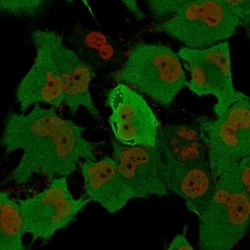
- Experimental details
- Immunofluorescent staining of permeabilized human T98G cells with recombinant PGP9.5 antibody cocktail (green, clone rUCHL1/775) and Nucspot (red).
Supportive validation
- Submitted by
- NSJ Bioreagents (provider)
- Main image
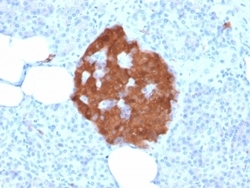
- Experimental details
- IHC staining of FFPE human pancreas tissue with recombinant PGP9.5 antibody (clone rUCHL1/775). Required HIER: boil tissue sections in pH6, 10mM citrate buffer, for 10-20 min followed by cooling at RT for 20 min.
- Submitted by
- NSJ Bioreagents (provider)
- Main image
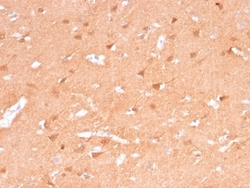
- Experimental details
- IHC staining of FFPE human cerebellum tissue with recombinant PGP9.5 antibody (clone rUCHL1/775). Required HIER: boil tissue sections in pH 9 10mM Tris with 1mM EDTA for 10-20 min followed by cooling at RT for 20 min.
- Submitted by
- NSJ Bioreagents (provider)
- Main image

- Experimental details
- IHC staining of FFPE human pancreas tissue with recombinant PGP9.5 antibody (clone rUCHL1/775). Required HIER: boil tissue sections in pH 9 10mM Tris with 1mM EDTA for 10-20 min followed by cooling at RT for 20 min.
Supportive validation
- Submitted by
- NSJ Bioreagents (provider)
- Main image
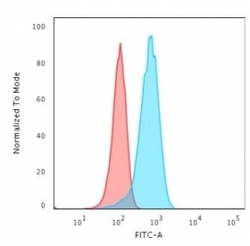
- Experimental details
- Flow cytometry testing of permeabilized human T98G cells with recombinant PGP9.5 antibody (clone rUCHL1/775); Red=isotype control, Blue= recombinant PGP9.5 antibody.
Supportive validation
- Submitted by
- NSJ Bioreagents (provider)
- Main image
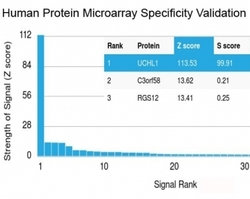
- Experimental details
- Analysis of HuProt(TM) microarray containing more than 19,000 full-length human proteins using recombinant PGP9.5 antibody (clone rUCHL1/775). These results demonstrate the foremost specificity of the rUCHL1/775 mAb.Z- and S- score: The Z-score represents the strength of a signal that an antibody (in combination with a fluorescently-tagged anti-IgG secondary Ab) produces when binding to a particular protein on the HuProt(TM) array. Z-scores are described in units of standard deviations (SD's) above the mean value of all signals generated on that array. If the targets on the HuProt(TM) are arranged in descending order of the Z-score, the S-score is the difference (also in units of SD's) between the Z-scores. The S-score therefore represents the relative target specificity of an Ab to its intended target.
- Submitted by
- NSJ Bioreagents (provider)
- Main image
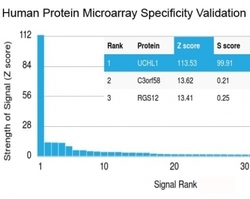
- Experimental details
- Analysis of HuProt(TM) microarray containing more than 19,000 full-length human proteins using recombinant PGP9.5 antibody (clone rUCHL1/775). These results demonstrate the foremost specificity of the rUCHL1/775 mAb.Z- and S- score: The Z-score represents the strength of a signal that an antibody (in combination with a fluorescently-tagged anti-IgG secondary Ab) produces when binding to a particular protein on the HuProt(TM) array. Z-scores are described in units of standard deviations (SD's) above the mean value of all signals generated on that array. If the targets on the HuProt(TM) are arranged in descending order of the Z-score, the S-score is the difference (also in units of SD's) between the Z-scores. The S-score therefore represents the relative target specificity of an Ab to its intended target.
Supportive validation
- Submitted by
- NSJ Bioreagents (provider)
- Main image
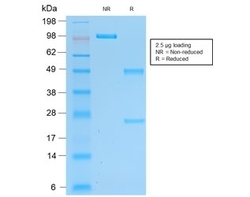
- Experimental details
- SDS-PAGE analysis of purified, BSA-free recombinant PGP9.5 antibody (clone rUCHL1/775) as confirmation of integrity and purity.
- Submitted by
- NSJ Bioreagents (provider)
- Main image

- Experimental details
- SDS-PAGE analysis of purified, BSA-free recombinant PGP9.5 antibody (clone rUCHL1/775) as confirmation of integrity and purity.
 Explore
Explore Validate
Validate Learn
Learn Western blot
Western blot